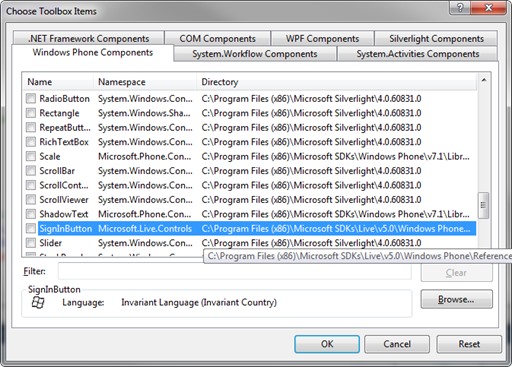Live SDK筆記5-SkyDrive Explorer, Windows Phone 7版
| | | 7 | |
一連寫了四篇筆記,介紹了Live SDK,也實際玩過取得使用者Live ID身分、連上SkyDrive等把戲:
- Live SDK筆記1-簡介
- Live SDK筆記2-註冊App與基本術語
- Live SDK筆記3-使用Live ID登入ASP.NET網站
- Live SDK筆記4-SkyDrive Explorer, ASP.NET版
埋了這些哽,其實背後我最想做的,是從WP7程式連上SkyDrive!
手機基於儲存空間的限制,以及跨裝置/平台共享的需求,非常需要結合網路儲存空間做為後盾,而WP7配上微軟體系的SkyDrive,感覺上是很棒的組合。
Live SDK有提供WP7專用的元件庫,下載安裝Live SDK後,可在WP7專案參照中找到Microsoft.Live及Microsoft.Live.Controls,學習中心有篇WP7整合Live SDK教學,是很好的入門。

Live SDK提供SignInButton控制項,表面上是顆登入登出鈕,背地則幫我們處理掉在App內嵌瀏覽器載入Live帳號登入網頁以及同意網頁等繁瑣細節,是整合Live SDK最簡便的做法。如果在Visual Studio工具箱沒看到它,可自行找到Microsoft.Live.Controls.dll加入工具箱(如下圖)。

不過,有一點要注意,由於在App運作時,不像在ASP.NET範例中會有Callback.aspx負責接入Authorization Code再呼叫API取得Access Token。請參考註冊App一文第3點提及的做法,申請Client ID時,Redirect Domain請留白,然後勾選"Mobile client app"為"Yes",如此,此Client ID即可使用httqs://oauth.live.com/desktop做為Redirect Page,並直接取得Access Token,如此在行動裝置上即可獨立運作。
我想試做的玩具是一個SkyDrive簡易瀏覽器,功能跟上一篇的ASP.NET版差不多,取得使用者對wl.skydrive範圍的同意權後,列出使用者SkyDrive下的目錄,點選目錄可展開列出其下的子項目,若是檔案則可進行檢視,不過WP7能支援的檔案格式比PC少,我只先選擇對圖片(jpg, png)及影片(wmv, mp3, mp4)提供檢視功能。
MainPage.xaml放入一個SignInButton及ListBox:
<Grid x:Name="LayoutRoot" Background="Transparent">
<Grid.RowDefinitions>
<RowDefinition Height="Auto"/>
<RowDefinition Height="*"/>
</Grid.RowDefinitions>
<StackPanel x:Name="TitlePanel" Grid.Row="0" Margin="12,17,0,28">
<TextBlock x:Name="ApplicationTitle" Text="Mini SkyDrive Explorer"
Style="{StaticResource PhoneTextNormalStyle}"/>
<my:SignInButton x:Name="btnSignIn" Branding="Skydrive"
SessionChanged="btnSignIn_SessionChanged" CientId="0000000016888888"
RedirectUri="https://oauth.live.com/desktop"
Scopes="wl.signin wl.basic wl.skydrive"/>
</StackPanel>
<Grid x:Name="ContentPanel" Grid.Row="1" Margin="12,0,12,0">
<ListBox x:Name="DirList" FontSize="36"
MouseLeftButtonUp="DirList_MouseLeftButtonUp">
</ListBox>
</Grid>
</Grid>
MainPage.xaml.cs則加入程式邏輯,主要原理是在使用者完成登入及同意後(btnSignIn_SessionChanged事件)建立一個LiveConnectClient,即可使用它呼叫REST API執行各種操作。呼叫結果由client_GetCompleted事件解析,相關的註解說明我附加在程式裡,所以直接看Code:
using System; using System.Collections.Generic; using System.Windows.Input; using Microsoft.Phone.Controls; using Microsoft.Live; using Microsoft.Live.Controls; namespace MiniSkyDriveExplorer { public partial class MainPage : PhoneApplicationPage
{ // Constructor public MainPage() { InitializeComponent();
}
private LiveConnectClient client = null;
private void btnSignIn_SessionChanged(object sender,
LiveConnectSessionChangedEventArgs e)
{ if (e.Status == LiveConnectSessionStatus.Connected) { DirItem.LiveSession = e.Session;
client = new LiveConnectClient(e.Session); client.GetCompleted +=
new EventHandler<LiveOperationCompletedEventArgs>( client_GetCompleted);
//呼叫me/skydrive,取得根目錄folderId client.GetAsync("me/skydrive", new MyUserState(ApiMethod.SkyDriveProp)); }
}
private const string goUpperSymbol = "\t";
//所有的REST API呼叫動作完成後,都會觸發此段解析回傳結果 //為降低範例程式複雜度,以下並未包含防呆容錯的邏輯,實際開發時應補上 void client_GetCompleted(object
sender, LiveOperationCompletedEventArgs e)
{ MyUserState state = e.UserState as MyUserState; if (state == null) return;
switch (state.Method) { //取得SkyDrive主資料夾的folderId case ApiMethod.SkyDriveProp: //取出id,列出根目錄下的項目 ListFiles(e.Result["id"].ToString()); break; //取得目錄清單 case ApiMethod.SkyDriveDir: //由data取得陣列 List<object> items = e.Result["data"] as List<object>;
if (items != null)
{ DirList.Items.Clear();
DirList.DisplayMemberPath = "DisplayName"; //加入回上層的邏輯 if (folderIdStack.Count > 1) { DirItem di = new DirItem(goUpperSymbol, "[..]");
DirList.Items.Add(di);
}
foreach (Dictionary<string, object> item in items)
{ DirItem di = new DirItem( item["id"].ToString(), item["name"].ToString() );
//資料夾時額外取得子項目數 if (di.IsFolder) di.Count = int.Parse(item["count"].ToString());
else //檔案則取得下載網址
di.SrcUrl = item["source"].ToString(); //加入清單 DirList.Items.Add(di);
}
}
break; }
}
//用以保存上層目錄的folderId private Stack<string> folderIdStack = new Stack<string>();
private void ListFiles(string folderId)
{ if (client == null) return;
if (folderId == goUpperSymbol) { folderIdStack.Pop();
folderId = folderIdStack.Peek();
}
else folderIdStack.Push(folderId); client.GetAsync(folderId + "/files", new MyUserState(ApiMethod.SkyDriveDir)); }
private void DirList_MouseLeftButtonUp(object sender,
MouseButtonEventArgs e)
{ DirItem di = DirList.SelectedItem as DirItem; //資料夾的話,繼續展開 if (di.IsFolder || di.Id == goUpperSymbol) ListFiles(di.Id); //否則試著下載回來檢視 else { DirItem.Current = di; //將此DirItem設為Current NavigationService.Navigate(
new Uri("/Viewer.xaml", UriKind.Relative));
}
}
}
}
為了讓程式更結構化一點,我宣告了一個很簡單的SkyDrive項目物件模型: (即上面MainPage.xaml.cs中所出現DirItem、MyUserState物件的由來)
using System; using System.Net; using System.Windows; using System.Windows.Controls; using System.Windows.Documents; using System.Windows.Ink; using System.Windows.Input; using System.Windows.Media; using System.Windows.Media.Animation; using System.Windows.Shapes; using Microsoft.Live; namespace MiniSkyDriveExplorer { #region 用以記錄REST API呼叫資訊的狀態物件 public enum ApiMethod
{ SkyDriveProp, // me/skydrive SkyDriveDir, // folderId/files SkyDriveGetImage,
SkyDriveGetMedia
}
public class MyUserState
{ public ApiMethod Method; public string FileName;
public MyUserState(ApiMethod method) { Method = method;
}
}
#endregion #region 簡單的目錄物件 public class DirItem
{ //是否為資料夾 public bool IsFolder
{ get { return Id.StartsWith("folder"); } }
//顯示名稱 public string Name;
//foderId或fileId public string Id;
//上層資料夾的folderId public string ParentId;
//若為資料夾時,標示其下項目數 public int Count;
//下載來源URL public string SrcUrl;
//顯示名稱,資料夾為[folderName](count),檔案則為fileName public string DisplayName
{ get
{ return IsFolder && !Name.Equals("..") ?
string.Format("[{0}]({1})", Name, Count) : Name;
}
}
public DirItem(string id, string name)
{ Id = id;
Name = name;
}
//用此靜態屬性當作頁面間的傳遞媒介 public static DirItem Current = null;
//供跨頁面共用LiveConnectSession public static LiveConnectSession LiveSession = null;
}
#endregion }
除了SkyDrive清單展示,我另外做了一個Viewer.xaml,用來呈現SkyDrive中的圖片(png, jpg)及媒體檔(wmv, mp3, mp4)。
註: Windows Phone模擬器不支援部分媒體格式,測試前可先看一下MSDN文件,其中有些已註明This codec is unsupported in Windows Phone Emulator的格式,測試前請認清,以免在模擬器上猛試不成白花時間! (謎之聲: 這條註解怎麼隱含著強烈的怨念?)
要從SkyDrive下載檔案,可以透過LiveConnectClient.DownloadAsync輕鬆達成,在client_DownloadCompleted事件中可以直接取得byte[],十分方便。媒體檔的部分,我還沒試出可以串流播放的做法,所以先採行的方式是先將下載結果存成IsolatedStorageFile,再叫出MediaPlayerLauncher進行播放。程式範例如下:
using System; using System.Linq; using System.Windows; using System.Windows.Controls; using Microsoft.Phone.Controls; using Microsoft.Live; using System.Windows.Media.Imaging; using System.IO.IsolatedStorage; using Microsoft.Phone.Tasks; namespace MiniSkyDriveExplorer { public partial class Viewer : PhoneApplicationPage
{ public Viewer() { InitializeComponent();
}
private string[] imgExts = "png,jpg".Split(',');
private string[] mediaExts = "wmv,mp3,mp4".Split(',');
private LiveConnectClient client = null;
private void PhoneApplicationPage_Loaded(object sender, RoutedEventArgs e)
{ if (DirItem.LiveSession == null || DirItem.Current == null)
return; //建立LiveConnectClient client = new LiveConnectClient(DirItem.LiveSession); client.DownloadCompleted +=
new EventHandler<LiveDownloadCompletedEventArgs>( client_DownloadCompleted);
//清空內容 ContentPanel.Children.Clear();
//取得要檢視的檔案 DirItem di = DirItem.Current;
ApplicationTitle.Text = di.Name;
//由副檔名決定開啟方式 string ext = System.IO.Path.GetExtension(di.Name).ToLower().TrimStart('.');
if (imgExts.Contains(ext)) client.DownloadAsync(di.SrcUrl, new MyUserState(ApiMethod.SkyDriveGetImage)); else if (mediaExts.Contains(ext))
//針對媒體檔,比較貼心的方式是透過Streaming方式播放 //此處只簡單示範整個檔案下載完畢後才撥放 client.DownloadAsync(di.SrcUrl,
new MyUserState(ApiMethod.SkyDriveGetMedia) { FileName = di.Name }); else ContentPanel.Children.Add(new TextBox() { Text = "Unsupported File Type" });
}
void client_DownloadCompleted(object sender, LiveDownloadCompletedEventArgs e)
{ MyUserState state = e.UserState as MyUserState; if (state == null) return;
switch (state.Method) { case ApiMethod.SkyDriveGetImage: BitmapImage bmp = new BitmapImage(); bmp.SetSource(e.Result);
Image img = new Image(); img.Source = bmp;
ContentPanel.Children.Add(img);
break; case ApiMethod.SkyDriveGetMedia: //此處採用將檔案下載儲存後再播放的做法 IsolatedStorageFileStream fs =
IsolatedStorageFile.GetUserStoreForApplication()
.CreateFile(state.FileName);
e.Result.CopyTo(fs);
fs.Close();
MediaPlayerLauncher mpl = new MediaPlayerLauncher() { Location = MediaLocationType.Data,
Media = new Uri(state.FileName, UriKind.Relative) };
mpl.Show();
break; }
}
}
}
程式實際執行結果如下,按下SignInButton後,畫面會變成Windows Live的登入畫面,使用者輸入Windows Live帳號並同意授權後:


程式便可透過me/skydrive REST API取得使用者SkyDrive根目錄的Id,接著使用folderId/files就可取回該目錄下所有子項目的資訊,以ListBox的方式展示出來。


檢視圖片及影片的範例:


很簡單吧!? 大家一起為WP7 App加入SkyDrive支援吧!
Comments
# by Eclipse
朋友介紹我來這個專欄查詢,我想請問一下有關於netcut這個程式,網路上流傳很多破解的方式包括arp -a那些有的沒的,我試過卻無法將網路恢復,對於破解此軟體的方式不知道您有什麼辦法呢? 我只是想好好的使用網路..
# by jain
看來暗黑大花了不少時間用模擬器測, 然後測不出結果吧 :p
# by 北京-wp开发者
博主你好,我想问你一个问题,就是在windowsPhone调用Live API的时候,能不能实现自动登录功能?就是不需要在手机中跳转到Live登录界面,直接进行操作。谢谢
# by Jeffrey
to 北京-wp开发者, 在Live SDK的設計理念裡,WP7 App不需也不應該接觸Live帳號及密碼,因此使用者會被導向Live登錄介面,經過同意授權後,之後並不需要每次都重新登入/授權。 事實上,使用者們也已開始習慣這類OAuth的運作流程,就是由App轉介到帳號來源的"官方網站"完成登入及授權再開始使用,要是發現不用敲帳號密碼也沒詢問授權,App就可以讀到SkyDrive裡的私人檔案,恐怕反而會心裡毛毛的。:P
# by 李东升
博主你好。看了你5篇笔记,对我帮助很大,知道skydrive开发的流程,我也在网上找了很多资料,但是都没有这5篇文章讲解的清楚。目前我在Android下进行skydrive开发,功能大致为把手机上的文件上传到skydrive上,由于开发进度比较紧张,而且是昨天刚接触skydrive开发,哪里可以找到Android开发的上传文件的例子,我想参考一下?
# by Jeffrey
to 李东升, github上可以找到Android的SkyDrive範例(https://github.com/liveservices/LiveSDK/tree/master/Samples/Android/SkyDriveAndroidSample),要上傳文件,不同平台間呼叫Live SDK API的方式大同小異,以範例為基礎加以修改應不難實現。
# by dsl services provider
I liked this post very much as it has helped me a lot in my research and is quite interesting as well.Great Inspiring blog. Thank you for sharing this information with us.